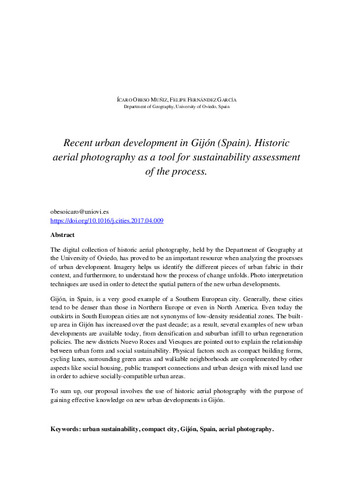Recent urban development in Gijón (Spain). Historic aerial photography as a tool for sustainability assessment of the process
Autor(es) y otros:
Fecha de publicación:
Versión del editor:
Citación:
Descripción física:
Resumen:
The digital collection of historic aerial photography, held by the Department of Geography at the University of Oviedo, has proved to be an important resource when analyzing the processes of urban development. Imagery helps us identify the different pieces of urban fabric in their context, and furthermore, to understand how the process of change unfolds. Photo interpretation techniques are used in order to detect the spatial pattern of the new urban developments. Gijón, in Spain, is a very good example of a Southern European city. Generally, these cities tend to be denser than those in Northern Europe or even in North America. Even today the outskirts in South European cities are not synonyms of low-density residential zones. The built-up area in Gijón has increased over the past decade; as a result, several examples of new urban developments are available today, from densification and suburban infill to urban regeneration policies. The new districts Nuevo Roces and Viesques are pointed out to explain the relationship between urban form and social sustainability. Physical factors such as compact building forms, cycling lanes, surrounding green areas and walkable neighborhoods are complemented by other aspects like social housing, public transport connections and urban design with mixed land use in order to achieve socially-compatible urban areas. To sum up, our proposal involves the use of historic aerial photography with the purpose of gaining effective knowledge on new urban developments in Gijón.
The digital collection of historic aerial photography, held by the Department of Geography at the University of Oviedo, has proved to be an important resource when analyzing the processes of urban development. Imagery helps us identify the different pieces of urban fabric in their context, and furthermore, to understand how the process of change unfolds. Photo interpretation techniques are used in order to detect the spatial pattern of the new urban developments. Gijón, in Spain, is a very good example of a Southern European city. Generally, these cities tend to be denser than those in Northern Europe or even in North America. Even today the outskirts in South European cities are not synonyms of low-density residential zones. The built-up area in Gijón has increased over the past decade; as a result, several examples of new urban developments are available today, from densification and suburban infill to urban regeneration policies. The new districts Nuevo Roces and Viesques are pointed out to explain the relationship between urban form and social sustainability. Physical factors such as compact building forms, cycling lanes, surrounding green areas and walkable neighborhoods are complemented by other aspects like social housing, public transport connections and urban design with mixed land use in order to achieve socially-compatible urban areas. To sum up, our proposal involves the use of historic aerial photography with the purpose of gaining effective knowledge on new urban developments in Gijón.
ISSN:
Patrocinado por:
Financial support from FPU grant (FPU14/04710) from the Spanish Ministry of Education is gratefully acknowledged. Furthermore, I would like to thank Observatorio del Territorio for their assistance with historic aerial photography(http://www.observatoriodelterritorio.es/).
Colecciones
- Artículos [37531]
- Geografía [380]
- Investigaciones y Documentos OpenAIRE [8305]
Ficheros en el ítem





